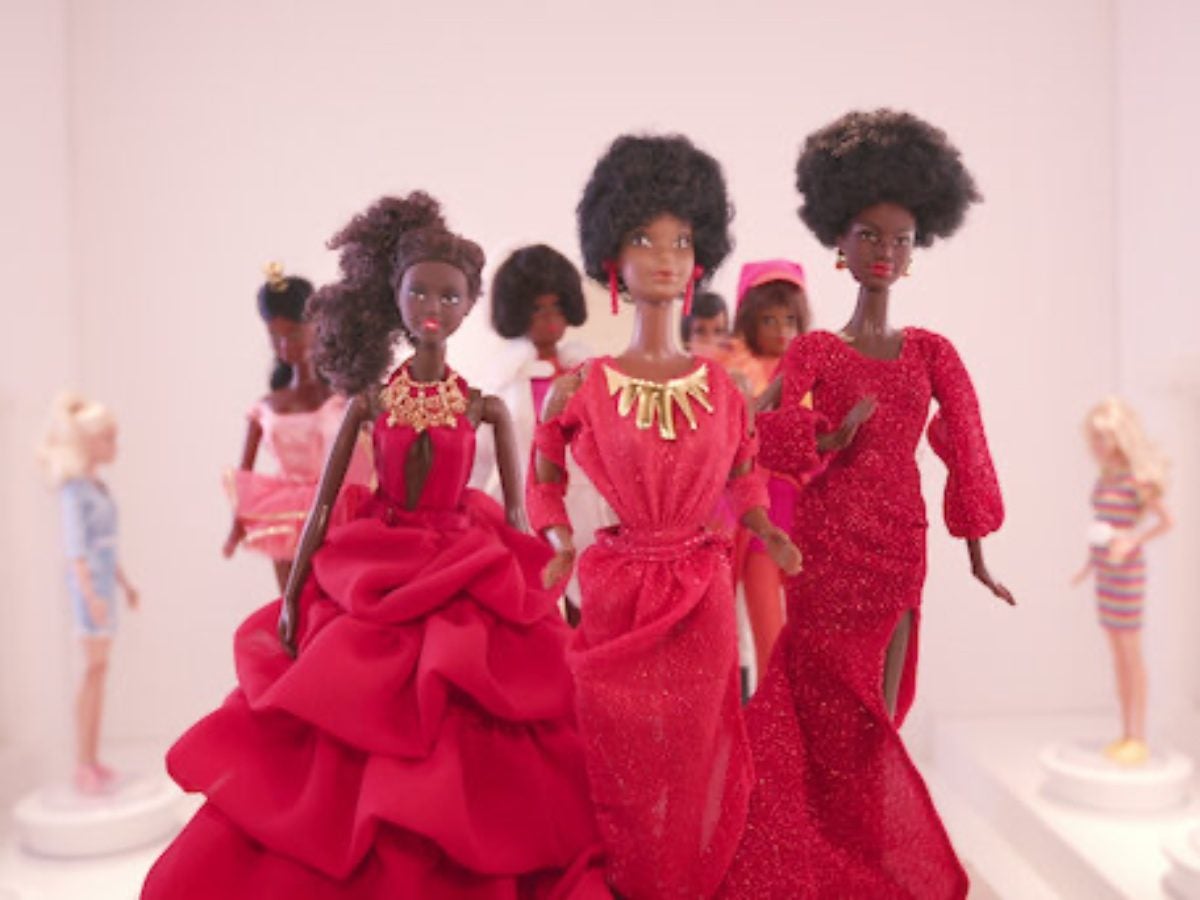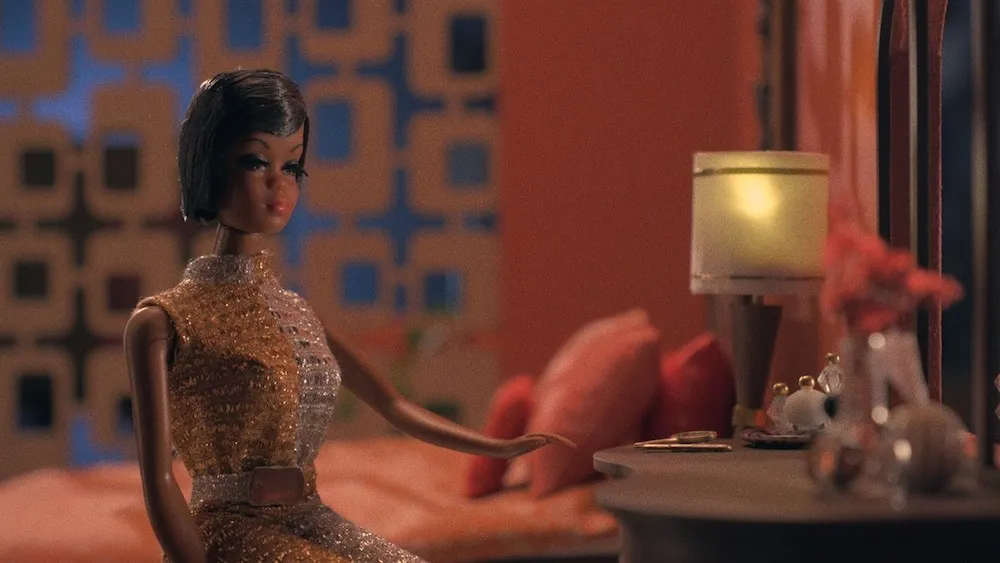 Courtesy of Netflix
Courtesy of Netflix  By Okla Jones ·Updated July 9, 2024
By Okla Jones ·Updated July 9, 2024
Black Barbie, the new documentary from Netflix tells the story of three Black women at Mattel responsible for spearheading the evolution of the Barbie brand in 1980. The film also explores the importance of representation and diversity, and how dolls can be critical to the way children see themselves for years to come.
Directed by Lagueria Davis, Black Barbie follows Beulah Mae Mitchell, Kitty Black Perkins, and Stacey McBride-Irby, and their involvement with the development of this groundbreaking project. The film itself materialized when Davis went to California as a young filmmaker to move in with Mitchell, her aunt. In seeing Mitchell’s doll collection–and her story about how they came to be–-Davis decided to examine the larger story of Black Barbie by creating a documentary for the world to see.
 Courtesy of Netflix
Courtesy of Netflix
“I think that Black Barbie, having Barbies and tools of imagination where little girls and boys can see themselves, completely see themselves, and not have to try to find themselves in something that doesn’t look like them or a standard that’s been set that is not connected to who they are naturally—it’s very important,” Davis says.
Ahead of the film’s release on June 19, Davis and producer Aaliyah Williams sat down with ESSENCE to discuss Black Barbie, how the documentary got started, the doll’s impact on popular culture, and so much more.
ESSENCE: How did you fall into your role with this film? How did that process come about?
Aaliyah Williams: It is such an interesting moment of serendipity. So, I got an email from a good friend, an industry colleague we’ve worked with and developed projects together, and she sent out this email saying, “I love this filmmaker. She just got her financing for this movie and she needs a producer,” and she attached Lagueria’s pitch deck at the time. And I was looking through the deck and I was shocked. Well, A, I love a good deck. It was beautiful and the visuals were fantastic. And I’m like, “Oh my God, who is this woman who’s making this?”
With everything that she was talking about, and saying that she wanted to get info of not just interviews but animation and wanting to talk to kids and things, I was just blown away by her vision. I was mostly struck by the fact that the first Black Barbie came out in 1980, which is the year that I was born. And I was like, “That’s nuts, that’s crazy.” So I think within an hour I emailed Lagueria and just expressed all of that to her. And we had several meetings and I think the last question that she needed to seal the deal was what my Zodiac sign was. And so she was down to work with a Pisces producer.
How about you, Lagueria?
Lagueria Davis: It came to me through a conversation with my aunt, Beulah Mae Mitchell. I moved to LA and she was gracious enough to let me stay with her while I found my bearings. We had a conversation—I knew that she worked for Mattel, but I didn’t know her story. And so she sat down and told me her story. And that story began with working at Mattel for 45 years, and being on that first Barbie line and asking, “Why not make a black Barbie? Why not make a Barbie that looks like me?” And as a filmmaker I was like, “Yo, there’s a story here.” So, I did some research and discovered Kitty [Perkins] and Stacey [McBride-Irby] and that beautiful line of representation and legacy.
How did the production of the first Black Barbie materialize?
LD: I don’t know if I can speak specifically how it went. Thinking in terms of my aunt saying it was ’60 or ‘61 when they were first asking for a Black Barbie and getting the Friends of Barbie Black Fashion Dolls with names. The first one would be in ’67—colored Francie. And then in ’68 they would introduce Christie, a black friend of Barbie. And so I think at that time and listening to my aunt, when they saw Christie and Francie, they thought they had arrived, that that was a Barbie. And to a lot of women in our film, they thought that was a Barbie. My aunt says it was almost an education to her and remembering when Kitty came on the scene. She said, “They should be able to make a Black Barbie with black features.”
AW: And she was brought on as the first black designer at Mattel and became the head designer for the Barbie brand overall. And then she was like, “Well, why haven’t we made a Black Barbie doll?” And it was through her that OG Black Barbie came on the scene.
LD: Seeing that representation, is having an understanding of the hierarchy of things.
I’m glad you said the word “representation.” How impactful do you think the creation of the Black Barbie was on our culture?
AW: I think it’s really impactful. Black Barbie came on the scene in 1980, the year I was born. So I missed her debut. I was focusing on fully developing as a human. But I will say I was, Lagueria and I talk about this all the time, this film and making this film has made me so grateful for my parents who were acutely aware of the Doll Test. And so we only had black dolls in the house. If someone ever gave us a white doll, I didn’t know about it, never ever saw it. And I’ll say that it’s been wonderful having the film out in the world now.
I had a friend call me, I shouldn’t say a friend, one of my sisters called me yesterday after watching the film and she was like, “Oh my God, this made me remember that I used to have white dolls and the first time I got a black doll, I stopped playing with those Barbies and I was only playing with the Black Barbie. And it really changed how I saw myself.”
Lagueria, in your words, why did you think it was important to tell the story of Mattel’s Black Barbie and its creation?
LD: Listening to my aunt and having a better understanding of what it meant for her to be there in that company and work her way into the office, being one of the Black people to move into that office and seeing when Kitty was brought in as a chief designer in 1976 and her being able to make Black Barbie reality, I was really just struck by that story and what it actually takes within a corporation to make something happen. And then introduce Stacey coming into fashion design because she saw what Kitty was doing. I just thought it was beautiful, to be honest. I thought it was just such a beautiful thing. And it was in a time where we didn’t have DEI, which for me feels so performative. This is just a beautiful story. No performance needed, it’s representation and action. We can say it matters all day. And I think our film really shows how it matters, why it matters and how it can work.
AW: Even beyond that, it really highlights black women leadership because all of this was possible, because a strong Black woman came into that corporate environment. It also speaks to leadership in mentoring and grooming people of all different backgrounds to come up and to be able to stand on their own. We talk a lot about that in the film and that’s what’s important. I think, especially in this industry that says, “we don’t have enough diversity in terms of filmmakers, in terms of writers, in terms of producers in film and television,” everyone’s quick to have a mentorship program. It’s like, no, no, just hire people and bring them up in the way that you were brought up.
LD: And we also touch on the film about how there isn’t a Kitty, there isn’t my aunt, there isn’t a Stacey at Mattel right now. And so it’s shining a light on exactly what Aaliyah just said. You want to think in terms of these DEI initiatives and mentorship programs, but it could be just as simple as that. Hire the people who also can sit at the table and be their authentic self. I love that. Tasha Kirkwood in the film, talks about diversity of thought because that’s another key component. And so what we saw were three bold women who weren’t afraid to ask the question and push for something that they wanted to see. They saw the need and they pushed to make it happen. They made it happen.
You said something that was really interesting–you said there’s no Kitty, there’s no Stacey, there’s no Mae at Mattel right now. Why do you think that is? Why do you think that it hasn’t grown since the first Black Barbie? Why is it regressing in your opinion?
LD: I don’t know if that’s a question for me. That’s a question for Mattel.
AW: Definitely a question for Mattel. I mean, but also indicative of where we are as a society. We enjoyed the first black president in President Barack Obama. And ever since then, it seems like there’s been a concerted effort to take steps back from that progress. And I think you see that replicated in a lot of different industries and Mattel is no different.
TOPICS: Black Barbie Netflix Shonda Rhimes
The post Netflix’s ‘Black Barbie’ Examines The Importance Of Representation And Diversity appeared first on Essence.
